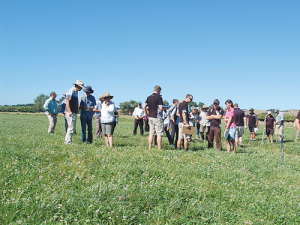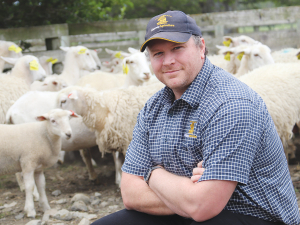Pasture renewal rates in New Zealand are very low, i.e. about 2.5% for sheep and beef farms and 8% for dairy farms, yet reasons and evidence abound that suggest much benefit from renewing older pastures.
Research shows there is awareness of the benefits of planting new pastures, but there are perceived barriers:
■ It is expensive
■ New grasses don’t persist
■ They need greater maintenance
■ It is too hard (to take paddocks out of production/difficult to fit into current farm management, etc) Planting new pastures is an ‘intensive’ farming practice, therefore unattractive to farmers who see themselves as running low input farming systems.
Thus, some farmers may appreciate the benefits but lack the knowledge or confidence to give it a go. Yet done properly the risks are minimal.
A big difference exists between your poorest-producing pastures and your best paddock; that difference in dry matter production will be affecting your bottom line.
Modern forage cultivars have been bred to improve productivity:
■ They establish quickly
■ They produce more dry matter per hectare
■ They resist pests and disease better
■ They are more palatable, making them easier to manage
■ They have a higher feed value (ME) so stock do better
■ They grow more feed than weed grasses in winter and summer.
■ There are a variety of cultivars that have been bred for specific conditions to suit every farm type and operation.
Replacing poor-producing paddocks with new pasture is profitable. It is among the simplest ways to invest onfarm for a significant and relatively predictable return.
The higher a farm’s performance, the more it can gain from intensifying its pasture renewal programme. But the benefits of pasture renewal are easily achieved in any sort of farming operation. Pasture renewal is not just a ‘high input’ farming practice; it can be incorporated into any farm management programme. And the benefits are obtainable by all grazing-based enterprises.
So why should I renew pasture? Because pastures deteriorate over time. Most productive pastures deteriorate over time from a combination of natural and induced causes: weed invasion -- particularly low quality grasses such as browntop, sweet vernal, crested dogstail, fine fescue, Yorkshire fog, or summer grasses such as paspalum and Mercer grass, dry/drought conditions, wet/flooding, poor fertility, poor drainage, diseases, insects, pugging, soil compaction, overgrazing and poor management.
Over time, the population of desirable, productive plants in a pasture declines, while populations of undesirable or unproductive plants increase and pastures become ‘runout’. Typically old pasture produces less dry matter, is lower in ME and stock preference, and this decline compounds as the pasture ages.
New pasture is significantly more productive
Typically successful pasture renewal will increase dry matter per hectare per year by about 3-6 tonnes (each year).
This is true of all farms, whether they are dairy or sheep, intensive or extensive, irrigated or not. Differences betweenthesegroupsarise,ofcourse, in the extent to which that extra production can be converted into additional income.
Control over seasonality of production
Modern pasture cultivars allow the farmer to choose the periods of the year when a new pasture will be most productive and when it goes to seed. Cultivars can be chosen to produce more grass in winter, summer and autumn than traditional pastures. Rye-grasses can be chosen with a more than six-week difference between the earliest and latest seeding dates. Farmers can pick cultivars to achieve the seasonal production peaks that create the best opportunities for them.
Consistently higher ME
New pastures consistently produce an average of 0.5 more megajoules of ME/kg DM. (Note this benefit is over and above the extra dry matter produced by a new pasture.)
Reasons include:
■ Higher proportion of desirable species
■ Later and more uniform flowering
■ Leafier sward, with fewer seed heads produced
■ Less dead leaf material.
Higher ME produces compounding benefit
These attributes make a new pasture sward more attractive to the grazing animal, and thus easier to manage for the control of quality during late spring and early summer, so helping maximise animal intakes and pasture utilisation.
As these pastures are grazed more uniformly, farmers can more easily control the quantity of residual dry matter when the animals are removed. Optimum post-grazing residual means optimum ME regrowth and therefore increased animal performance at the next productive grazing.
Access to new endophytes
Most new perennial ryegrass cultivars are available with the ‘novel’ endophytes developed to solve particular problems in different regions. The endophyte occurring naturally in NZ ryegrass pastures (variously called standard or wild endophyte) confers resistance of its host ryegrass plants to some insect pests, but it was found in the 1980s to cause ryegrass staggers and heat stress in animals.
Novel endophytes are continuing to be developed to maintain good animal health while enhancing the grass’s pest resistance characteristics. As well as Argentine stem weevil, novel endophytes confer resistance to pasture mealy bug, black beetle and root aphid, with more pests likely to be added to this list.
DairyNZ ran a three-year study comparing pastures with the novel AR1 and standard endophyte; the former produced 9% more milksolids than the latter.
• Tim Wood is project manager at the Pasture Renewal Charitable Trust
• This article first appeared in Getting the Basics Right 2017 edition


















